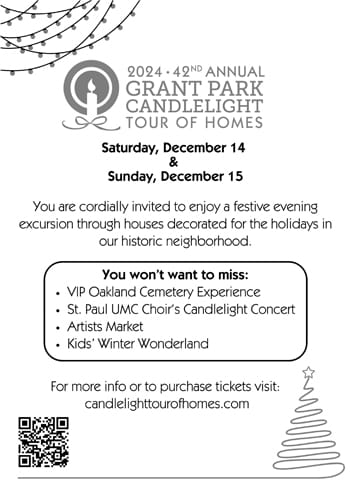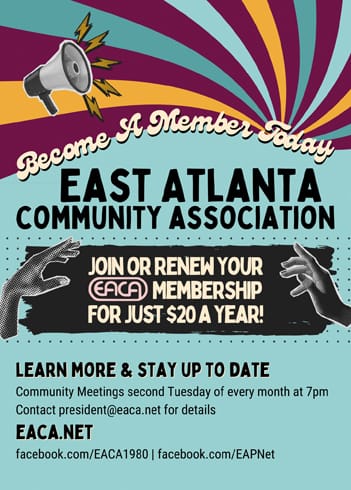By Ken Rose
People often ask each other about their hometowns. Our family moved to East Atlanta in 1997. I’ve lived here longer than anywhere else, and it is the only community my three kids have ever known. It’s our hometown.
One’s hometown evokes many memories. When people ask me about the town where I grew up, I usually remember my small town commercial district, my school, my friends, and my church. All of these things make up the hometown experience and define community. And all of these things define East Atlanta.
Many might take issue with religion as something that strengthens community. Some believe that communities of faith are at best sanctimonious and unnecessary or at worst hypocritical and destructive. Others believe that a community of faith is separate and apart from the physical community where they live. My experience reflects the complexity of a changing community of faith and its role in the community.
Martha Brown United Methodist Church is in the East Atlanta Village at the corner of Moreland Avenue and Metropolitan Avenue. This church is the oldest living institution in East Atlanta. Its membership stretches back to 1893. Originally christened the East Atlanta Methodist Church, the name was changed when one of the founders of East Atlanta, “Spanish” Jim Brown, donated the land for the site of the current church to honor his wife.
This church has seen generations of East Atlantans come and go. There is a picture in the church archives of young matrons from the early 20th Century that reminds me of East Atlanta today with its explosion of young families. Another photo shows grizzled Civil War veterans lined up in wheel chairs in the front of the church.
One of my favorite stories, passed onto me from the old timers, has to do with the “young boys” coming home from WWII. It seems that the teenagers were using a classroom on the first floor. When the boys came home from the war, they wanted this room for their new wives who were pregnant, so they wouldn’t have to climb the stairs. I’ve met several of these “young boys”. One, Roonie Walston, who recently passed, was at Pearl Harbor. Two men, John Harmon and JT Nash, still remain active in the church; one served on a bomber and the other on a submarine. Mr. Nash has been an usher at the church almost every Sunday since the end of the war. Ms. Nettie Nash, a perpetually cheerful woman, has spent her life supporting the United Methodist Children’s Home, a home for children without parents.
These people were born, went to school, and stayed to live their lives in their hometown. Many did leave the neighborhood because of the fear that was created during white flight. But they kept coming back to their hometown every Sunday. They contributed to their community in many ways. Martha Brown members were instrumental in founding Branan Towers. They arranged the transaction, raised money, and donated land. Once built, three sisters in the church drove the van for the Branan Tower residents for over 15 years, until they got too old to drive.
On several occasions in the 1980s, members had cars stolen or broken into, and the organist was even robbed at gunpoint practicing for Sunday services. But though they didn’t know how to reach out to the changing community around them, they often welcomed needy people from the street, like our friend Randy who today comes to Sunday school from time to time. He’s the guy you sometimes see on Moreland Avenue who walks with a cane bent at the waist. He often comes by for coffee and a chat with the old timers.
One thing is clear from my experience with these wonderful people. They love, cherish, and embrace their hometown. Martha Brown UMC was the center of this experience.
This church was at the heart of this community for many years and in many ways represents sacred ground in East Atlanta. The most obvious way is that it is a place where people have worshiped God. But just as important, it has served as a place where our community has gathered to seek support, heal, share friendships, and grow in love. In this way, it is sacred community space and is a place where many people have come to try to live their lives on this earth as best as they could.
Over the past eight years, this faith community has experienced a dramatic transition. Much like the young matrons of the last century or the young families after WWII, it is again a very young congregation from the neighborhood.
In our current state, like those who came before us, we share the notion that a viable community church is essential to our hometown. We seek to support the social relationships in our community that lift the spirit and support each other. We do this by providing the space for community associations, addiction recovery groups, girl scouts and boy scouts, children’s playgroups, social services, and other community gatherings.
Recently, all of this came into focus for me. Many people see church as a place of Christian worship for one hour or so a week. Some have been damaged by this experience while others have been lifted. For me, this church is one of the vital places that supports East Atlanta. It is a place where the community can gather and strengthen its bonds. This church is part of my hometown.
But more importantly, when my kids grow up and someone asks about their hometown, East Atlanta, my hope is that they will say that they remember the Village, their school, their friends, and their church.








Comments are closed.